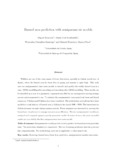Burned area prediction with semiparametric models

Ver/
Use este enlace para citar
http://hdl.handle.net/2183/16695
A non ser que se indique outra cousa, a licenza do ítem descríbese como Atribución-NoComercial-SinDerivadas 3.0 España
Coleccións
- GI-MODES - Artigos [141]
Metadatos
Mostrar o rexistro completo do ítemTítulo
Burned area prediction with semiparametric modelsAutor(es)
Data
2016-04-27Cita bibliográfica
Boubeta-Martínez, M.; Lombardía, M. J.; González-Manteiga, W. and Marey Pérez, Manuel F. (2016). "Burned area prediction with semiparametric models". International Journal of Wildland Fire
Resumo
[Abstract] Wildfires are one of the main causes of forest destruction, especially in Galicia (north-west Spain), where the area burned by forest fires in spring and summer is quite high. This work uses two semiparametric time-series models to describe and predict the weekly burned area in a year: autoregressive moving average (ARMA) modelling after smoothing, and smoothing after ARMA modelling. These models can be described as a sum of a parametric component modelled by an autoregressive moving average process and a non-parametric one. To estimate the non-parametric component, local linear and kernel regression, B-splines and P-splines were considered. The methodology and software were applied to a real dataset of burned area in Galicia for the period 1999–2008. The burned area in Galicia increases strongly during summer periods. Forest managers are interested in predicting the burned area to manage resources more efficiently. The two semiparametric models are analysed and compared with a purely parametric model. In terms of error, the most successful results are provided by the first semiparametric time-series model.
Palabras chave
Bootstrap
Burned area
Prediction
Semiparametric model
Time series
Forest fires
Burned area
Prediction
Semiparametric model
Time series
Forest fires
Versión do editor
Dereitos
Atribución-NoComercial-SinDerivadas 3.0 España
ISSN
1049-8001
1448-5516
1448-5516






